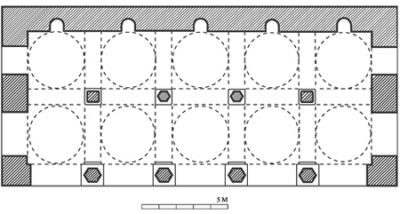Zafar Khan Ghazi Mosque and Dargah
Zafar Khan Ghazi Mosque and Dargah situated at Tribeni in hughli district, West Bengal, India, are considered to be among the earliest surviving Muslim monuments in Bengal. According to an inscription, the mosque is dated 698 AH/1298 AD. Tribeni (junction of three rivers viz, the Ganga, the Jamuna and the Sarasvati - hence the name) was an ancient holy place of the Hindus. The Muslims conquered it during the early phase of their conquest of Bengal.

The mosque is an oblong structure measuring 23.38m x 10.53m externally. It is the earliest surviving example of the brick-and-stone style introduced by the Muslims in Bengal in place of the traditional Hindu style of laying rectangular cut stones one upon another without mortar. The stones used in the mosque were originally materials from temples, as evidenced by figures of Hindu deities carved on some pieces. The original structure has suffered reconstruction a number of times.
There are five arched entrances in the east wall. Stumpy hexagonal stone piers support the arches. The mosque represents the multi-domed oblong type developed by the Muslims in Bengal in which the number of domes on the roof equals the number of entrances in the east wall multiplied by those on either side. The north and south walls have two doors each. There are thus ten domes roofing the mosque. The interior of the structure is broken into two longitudinal aisles and five short bays by means of stone pillars, creating ten equal compartments. The brick-built domes rest on stone pillars and pointed arches with brick pendentives at the corners.
The silhouette of the successive pointed arches has added to the spaciousness and grandeur of the mosque interior. Corresponding to the five entrances in the east, there are five mihrabs in the west wall contained within multifoil arches. The mihrab wall shows sparse decoration within panels. The cornice and the parapet of the structure are straight. The mosque follows the Bengali type with only the prayer chamber without court, riwaq and minaret. A significant feature of the mosque interior is that a brick wall up to the level of the arch-spring has closed the bay at each end, north and south, across the middle. These are the only parts of the mosque which show terracotta ornamentation. The southern part is in a fair state of preservation and shows a panelled composition. The central panel is broken into two halves vertically by means of rosettes within square frames - the lower depicting a swinging creeper with luxuriant leaf age and the upper two half-arch motifs with a finial in the thick of shrubs and foliage. The flanking panels are similarly disposed and ornamented. All the panels depict multifoil arches with finials. The vegetal motifs betray local influence and speak of the Muslim adaptive spirit.
The ornamentation of the northern bay wall is in ruins, but surviving traces show its dissimilarity from the southern. The composition here shows two small vertical panels each containing a multifoil arch with a finial from which hangs a chain ending in a round pendant. What is significant about these bay walls is that they are completely incongruous with the mosque interior but their ornamentation surprisingly resembles that in the bagha mosque (1524) in Rajshahi district.
Only yards away to the east of the mosque, beyond an open courtyard, stand two square rooms aligned east-west side by side, the western housing two graves - those of Zafar Khan Ghazi and his wife and the eastern showing four graves on a masonry platform. The walls are built of old temple materials - rectangular stone pieces - and the rooms are without a roof and open to the sky. A rectangular shallow niche enters them through a central door in the north wall flanked on either side with a trefoil arch above. The northern door of the western room is made up of a Hindu frame as shown by carved Hindu figures. The eastern room shows sculptured scenes from the ramayana and the mahabharata. There are other stone sculptures fixed at the plinth on the outer face. It is, however, surprising that the structure neither conforms to a Hindu temple nor to a Muslim tomb. What is probable is that it was built on a makeshift plan with reshuffled temple materials. The unsettled nature of Muslim occupation of the region at the time supports such a suggestion. [Muhammad Hafizullah Khan]
